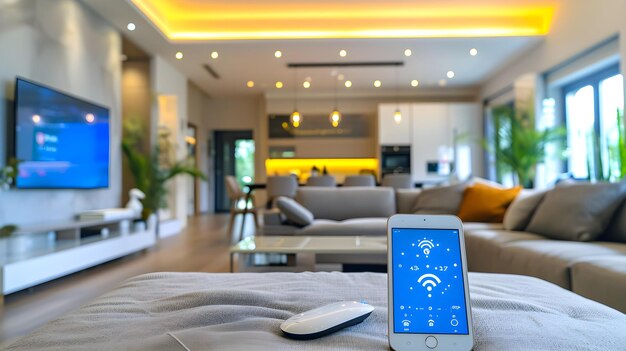Wireless home automation systems are revolutionizing modern living by providing convenience, energy efficiency, and enhanced security. These systems allow homeowners to control and automate various devices, including lighting, security cameras, thermostats, and entertainment systems, without the need for extensive wiring. This article explores the best wireless home automation systems, their features, benefits, and key considerations when choosing the right one.
1. Understanding Wireless Home Automation

Wireless home automation relies on communication technologies such as Wi-Fi, Bluetooth, Zigbee, and Z-Wave to connect and control smart devices. Users can operate these devices remotely via smartphones, voice assistants, or automation hubs.
Key Components of a Wireless Smart Home System
- Smart Hubs & Controllers: Central units that connect and manage multiple smart devices.
- Voice Assistants: AI-powered devices like Amazon Alexa, Google Assistant, and Apple Siri.
- Smart Lighting: Wireless bulbs, dimmers, and motion sensors.
- Smart Security: Cameras, door locks, and motion detectors.
- Climate Control: Smart thermostats for efficient temperature regulation.
- Entertainment Systems: Wireless speakers and streaming devices for home entertainment.
2. Top Wireless Home Automation Systems
A. Amazon Alexa Smart Home Ecosystem
- Works with a vast range of smart home devices.
- Supports voice control and automation routines.
- Compatible with Alexa-enabled smart speakers and displays.
B. Google Nest Smart Home System
- Integrates seamlessly with Google Assistant and Nest devices.
- Supports automation through Google Home App.
- Offers smart security, thermostats, and doorbells.
C. Apple HomeKit
- Ideal for Apple users with iPhones, iPads, and HomePods.
- Offers strong privacy and security features.
- Supports voice control via Siri and automation through the Apple Home app.
D. Samsung SmartThings
- Compatible with a wide range of third-party devices.
- Works with Zigbee, Z-Wave, and Wi-Fi smart home products.
- Offers advanced automation routines.
E. Hubitat Elevation
- Focuses on local automation for improved speed and privacy.
- Supports Zigbee and Z-Wave devices.
- Ideal for users who prefer a hub-independent system.
F. Wyze Smart Home System
- Budget-friendly smart home automation.
- Features security cameras, smart bulbs, and sensors.
- Easy to use and set up with the Wyze app.
3. Benefits of Wireless Home Automation

A. Convenience & Remote Access
- Control devices from anywhere via smartphone apps.
- Automate routines based on schedules and triggers.
B. Energy Efficiency & Cost Savings
- Smart thermostats optimize heating and cooling.
- Automated lighting and power management reduce energy waste.
C. Enhanced Security & Safety
- Smart security cameras and motion detectors provide real-time alerts.
- Remote locking and monitoring ensure home security even when away.
D. Scalability & Flexibility
- Easily add new devices to the system without rewiring.
- Compatible with various smart home brands and protocols.
4. Challenges of Wireless Home Automation
A. Internet Dependency
- Connectivity issues can affect system performance.
- Offline operation limitations in cloud-based systems.
B. Compatibility Concerns
- Not all devices work seamlessly across different platforms.
- Requires research to ensure device compatibility.
C. Security & Privacy Risks
- Smart home devices can be vulnerable to hacking.
- Strong security measures are needed, including encryption and two-factor authentication.
5. Future Trends in Wireless Home Automation

A. AI-Powered Smart Homes
- Increased use of artificial intelligence for predictive automation.
- AI-driven security systems with facial recognition and behavior analysis.
B. Matter Protocol for Universal Compatibility
- A new standard to improve smart home device interoperability.
- Supported by Apple, Google, Amazon, and other major brands.
C. 5G-Enabled Smart Homes
- Faster and more stable connectivity for seamless automation.
- Lower latency for real-time smart home responses.
D. Sustainable & Eco-Friendly Smart Homes
- Smart energy management solutions to reduce carbon footprints.
- Integration of renewable energy sources with smart automation.
Also Read : Smart Lighting Automation For Home: Enhancing Ambience With AI And IoT
Conclusion
Wireless home automation systems offer convenience, security, and energy efficiency, making modern living smarter and more comfortable. Whether you choose Amazon Alexa, Google Nest, Apple HomeKit, or other systems, it’s essential to consider compatibility, security, and scalability when building your smart home. As AI, 5G, and Matter Protocol continue to evolve, the future of smart home automation promises even greater innovation and seamless integration.
FAQs
1. What is the best wireless home automation system?
The best system depends on user preferences and existing devices. Amazon Alexa, Google Nest, Apple HomeKit, and Samsung SmartThings are among the top choices.
2. Can I integrate different brands of smart devices?
Yes, but compatibility depends on the system. Using a hub like SmartThings or Matter-compatible devices can help ensure seamless integration.
3. Is wireless home automation secure?
Security risks exist, but using strong passwords, encryption, and secure networks can help protect smart home devices.
4. How much does a wireless home automation system cost?
Costs vary based on the system and number of devices. Budget-friendly options like Wyze exist, while premium systems like Apple HomeKit can be more expensive.
5. What is the future of wireless home automation?
Future trends include AI-driven automation, universal Matter compatibility, 5G connectivity, and sustainable energy management solutions.

